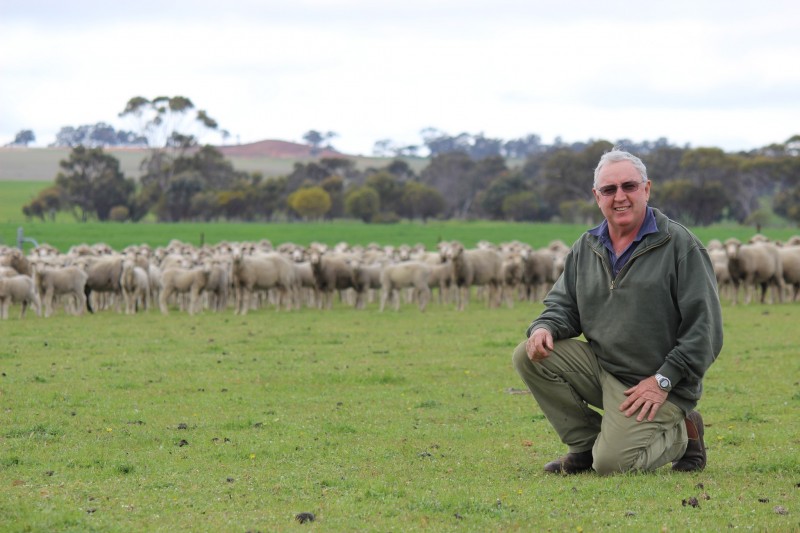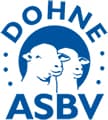Pingelly farmer settles on Dohne breed
By CAITLYN BURLING – Farm Weekly
WORKING for 19 years as a biosecurity officer for the Department of Agriculture and Food, Harry Williams has seen a lot of sheep breeds come and go. Different trials producing compelling results led him to try Dohnes for the first time in 2004 on his own 240 hectare farm at Pingelly, and they performed so well he has never looked back.
He initially started with a base of Australian Merino Society (AMS) bred ewes, which he was joining to Poll Dorset rams to produce an F1 prime lamb, but when the price of purchasing replacement ewes went through the roof, Harry knew something had to change. He bought two Merino rams and one Dohne ram to join to his existing Merino base and found the performance of the Dohne progeny to be faster growing and more robust than their pure Merino counterparts.
So from 2005 onwards, Harry and his wife Sandra have been on a Dohne drive towards a pure Dohne flock and currently run 540 ewes that range from F1 to F3, with the first lot of F4s on the ground this year. “Our AMS ewes gave us a good start with breeding a bigger sheep, because they already had a large frame about them,” Harry said. “When we first put the Dohne rams over them I was shocked at how small the first lamb was.
Pingelly farmer Harry Williams has been breeding Dohnes for the past 10 years, gradually moving towards a pure Dohne flock to continue producing a profitable, multi-purpose sheep.
“I thought we had done something wrong, but within a day it got up and going, and just didn’t stop growing from there. “So they are very good lambers and we continue to be impressed at just how fast they can grow.” They bought their initial
Dohne rams from local Brookton/Pingelly stud Pinedale, and since it dispersed, Harry now buys rams from Katanning Dohne studs Dowell and Koobelup. When he selects his breeding stock, Harry said he always chases a high eye muscle
depth figure and initially was after a negative fat index to produce more meat.
But as the years have progressed, he has reversed his view on fat and now looks for positive fat figures, together with any rams that are twins and have fine wool traits. Joining has also been reviewed, almost by accident after the ewes became mixed up with the rams a month earlier than they were supposed to back in 2002. Harry noticed the lambs seemed to thrive and were noticeably heavier in a short amount of time, so joining has been permanently moved from February to January for a six week period.
This also brought forward lambing from the start of July to the beginning of June, and Harry continues to achieve an average of 108 per cent lambing at a time of year when plenty of feed is coming to fruition. Feeding his sheep is one of Harry’s top priorities and despite not doing any pregnancy scanning, his philosophy is to feed all his ewes as if they are pregnant with twins.
“I probably feed a lot more than most farmers,” he said. “My theory is, a fat sheep will conceive easier, lamb easier, rear their offspring better and recover quicker to be ready to conceive again. “The only cropping I put in is 60 hectares of oats and that’s all for sheep feed. “On average I feed out 100 tonnes of oats every year and only start selling whatever oats are left over once feeding is finished.”
As soon as the grasses start to dry off, the lambs are weaned in mid-September onto feeders full of oats and a Great Southern stock lick and Harry said they don’t miss a beat and continue to gain weight. All of the wethers are shorn in late January and sold three weeks later as prime lambs through the local Landmark agents, usually to processors or butchers. The rest of the lambs are sold periodically as they reach the ideal weight parameters and all of them will have left the Williams’ farm by the end of May, before the next lot of lambs are about to arrive.
While the meat component of their Dohne flock is their main focus, producing a wool cut is also a handy source of additional income for Harry and Sandra, with the main shearing occurring in April. The lambs usually average between 17 and 18 micron, while the main ewe flock sits around the 21.5 micron mark, cutting about 4kg on average across both ewes and lambs. Shearers are happy to take on the large-framed, plainbodied Dohnes, the conformation of which has also allowed Harry to cut out mulesing the wethers altogether, with the ewes not far behind.
“I just think the Dohne has been the best breed for us,” Harry said. “There’s less hassle with shearing and mulesing, and we are getting a premium for producing a prime lamb.
“They give me a bit of everything and we just see them as a good, solid, multipurpose sheep.”











 Facebook
Facebook YouTube
YouTube Instagram
Instagram